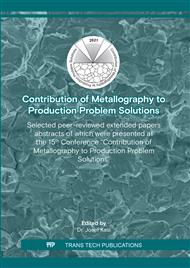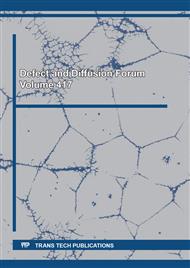p.73
p.81
p.87
p.95
p.101
p.111
p.117
p.123
p.131
Analysis of a Damaged Drill Made from Hs 2-9-1-8 Steel
Abstract:
This article aims to explain the reasons leading to the damage of a drill during its final grinding. Metallographic analysis using light and scanning electron microscopy was used to determine whether the damage was related to the structure of the material, which is given by its chemical composition, forming, and especially its heat treatment, or the grinding methodology. The drill was made of HS 2-9-1-8 tool steel. Fractographic analysis showed a cleavage fracture. In terms of the heat treatment used, the measured hardness of the analysed samples was appropriate for the requirements and possibilities of the tool steel. The metallographic analysis showed that the microstructure contained areas with clusters of primary carbides. These clumps significantly reduce the toughness of the material. In addition, there was a structural notch in the form of a white layer with a higher carbon content on the outer circumference of the samples. This layer also significantly contributed to the reduction of toughness. The hardened layer below the structural notch also contributed to the reduction in toughness. All of these microstructural defects were caused by poor grinding, which led to damage to the tool.
Info:
Periodical:
Pages:
101-107
Citation:
Online since:
June 2022
Authors:
Price:
Сopyright:
© 2022 Trans Tech Publications Ltd. All Rights Reserved
Share:
Citation:



